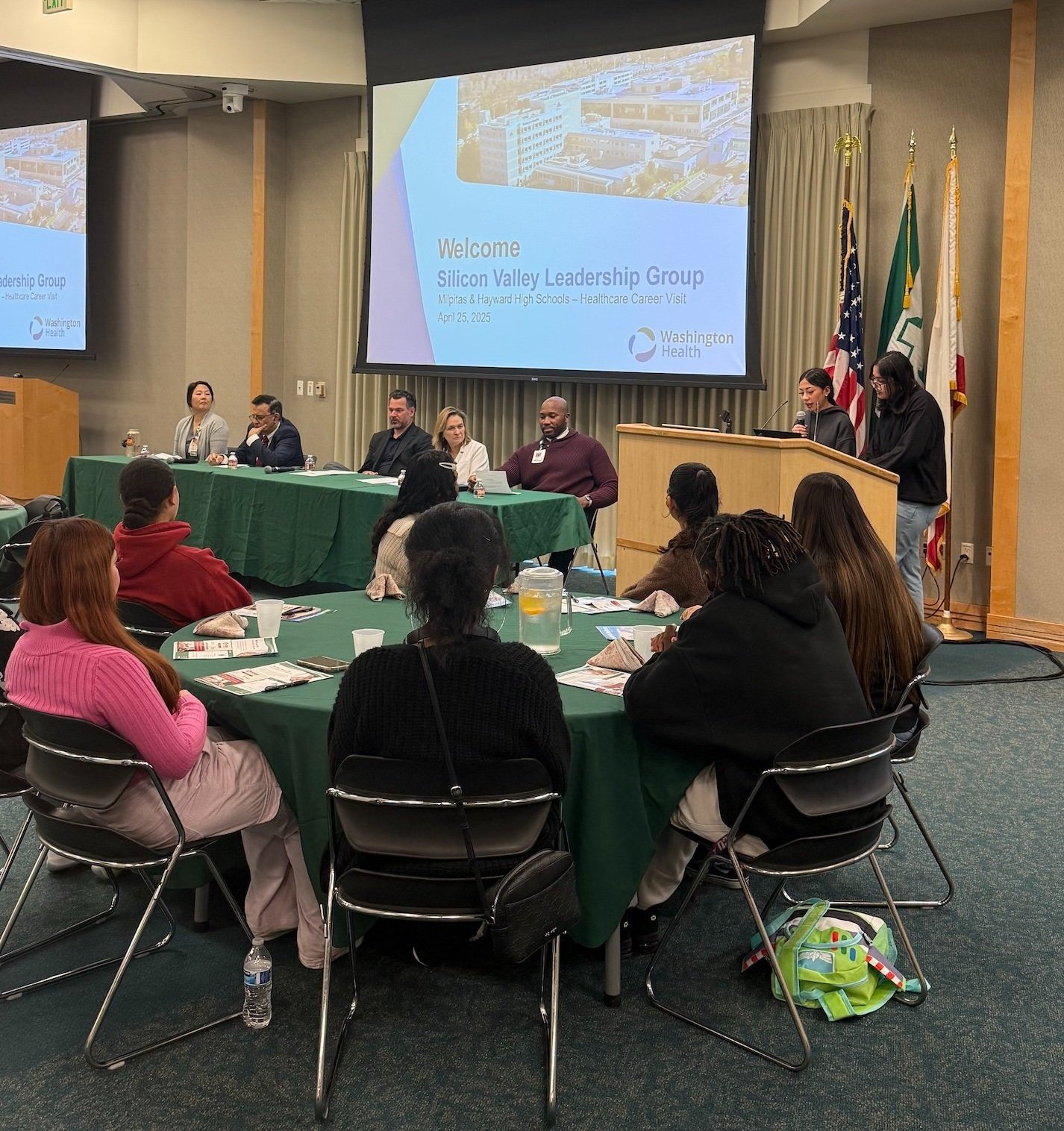Pathways to Purpose: Bay Area High School Students Envision Careers at Washington Hospital
On April 25, 2025, over 50 students from Hayward High School and Milpitas Middle College High School stepped into the world of healthcare—not through textbooks or lectures, but through hands-on training, personal conversations, and transformative storytelling at Washington Health (WH).
The students, all enrolled in health-pathways courses at their schools, participated in this immersive learning as part of the Bay Area K-16 Collaborative Worksite Visit series. Co-organized by SVLG and Washington Health, the series aims to build equitable pathways into high-demand careers for students from communities underrepresented in STEM.
As is typical for a BAK-16C worksite visit, the engagement started well before students set foot on campus. In the days leading up to the visit, Kayla Gupta, Washington Health’s Community Outreach Manager, hosted a virtual orientation session with students. She answered questions, introduced the hospital’s mission, and helped students feel prepared and excited for what was ahead. That intentional pre-engagement helped build trust and buy-in before the buses even rolled out.
When students arrived, they took the lead. Three student moderators—Lianna and Miriam from Milpitas, and Niklaus from Hayward—facilitated a panel with medical professionals representing a range of careers across WH. Professionals included Terence Taylor, Manager of Radiation Oncology; Garrett Cordes, Trauma Outreach Coordinator; Dr. Rohit Sehgal, Chief of Cardiology; Victoria Feng, Physical Therapist; and Kathy Weinberg from Critical Care.
Panel questions were written by the students themselves and reflected their curiosity about both the personal and professional sides of healthcare. The Milpitas team asked:
“Were there any experiences in high school or college that prepared you for a healthcare career?”
“How do you approach patient communication, especially with complex medical information?”
“What are some benefits and downsides of working in a hospital setting?”
The Hayward student lead followed up with a different lens, asking:
“What’s one thing you wish you knew when you started your career?”
“What’s the most difficult part of your job, physically or emotionally?”
“What’s the biggest health challenge you see today?”
Panelists responded with warmth and candor, offering practical advice and personal reflections. They shared their educational journeys, the pressures of clinical life, and the motivation they draw from serving their community. Their stories helped students understand that the healthcare field is vast, and that there's more than one way to find your place within it.
After the panel, students rotated through hands-on training modules in “Stop the Bleed” and choking first aid. They learned how to apply tourniquets, pack wounds, and perform abdominal thrusts. For many, this was the first time practicing real emergency techniques, and it made the prospect of a healthcare career feel tangible.
“This definitely has given me a greater understanding of what's possible in a hospital setting that isn’t just being a doctor.”
— Emily, Hayward HS
The tone of the day was welcoming and team-oriented. Hospital staff joined students for lunch in small discussion groups, where conversations continued informally. Students asked about navigating school, balancing work and life, and staying motivated. The authenticity of these interactions left a lasting impression.
"It was made clear that healthcare providers act like a large team. The staff really want to make their community a better place."
— Niklaus, Hayward High School
For many, the visit was more than informative—it was transformative. One student said it helped her discover that nursing was her calling. Another said she finally understood how her public health major could evolve into a meaningful career. A standout moment came when one student praised a WH staffer, Amman, for his approachability and humor, saying, “He treated us like family. I would consider him a tio!”
As students boarded the buses home, many carried more than just memories—they left with a new sense of possibility. What began as a simple field trip became a catalyst for self-discovery, sparking questions about purpose, identity, and impact.
For Washington Health, it was an opportunity to give back and plant seeds for a future workforce grounded in empathy and excellence. For the Bay Area K-16 Collaborative and SVLG, the day reaffirmed that when industry and education come together with intentionality, equity, and heart, we can open doors that once seemed closed—and help the next generation walk through them with confidence.



